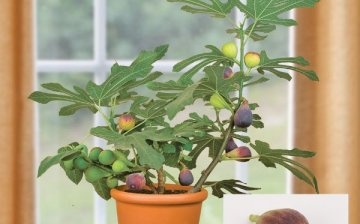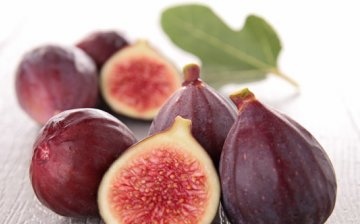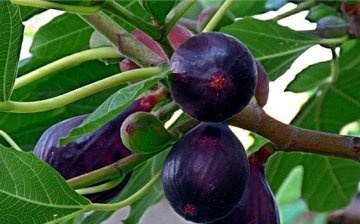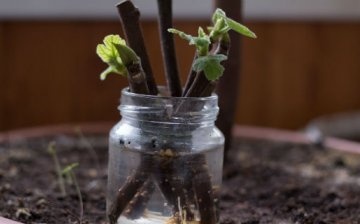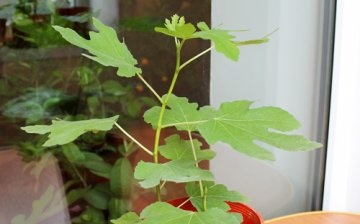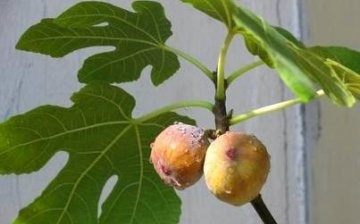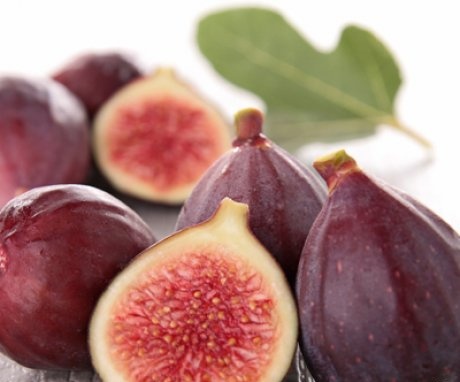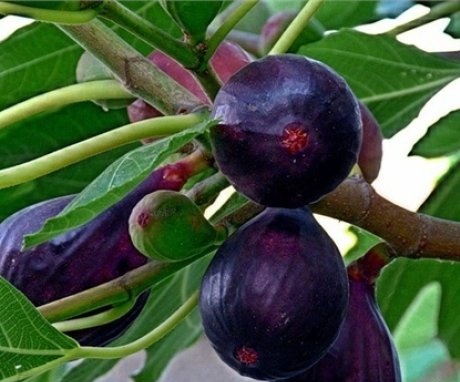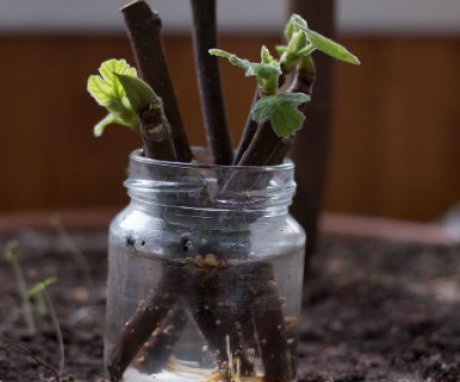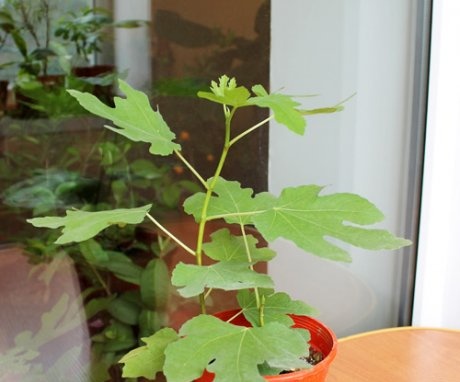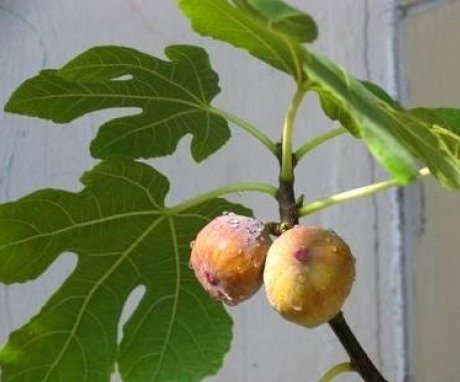Fig indoor and its cultivation at home
During its existence, figs have acquired many names. It is called a wine berry, fig or fig tree, fig or fig tree. The genus of figs is deciduous ficuses. The plant is a bushy tree that can grow up to three meters in height.
Some specimens can reach fifteen meters. The trees are covered with light gray bark and consist of thick, weakly branched branches. Hard, hairy leaves, beautifully carved. The outer part of the leaf plate is green and the inner part is grayish green. In case of damage to shoots or leaves, a thick milky sap is intensively released.
Content:
- Description of figs
- Fig varieties for home windowsill
- Fig tree propagation methods
- Providing care for a comfortable life of figs
- What diseases and pests need to protect the plant from
Description of figs
The female plants are called figs. It is they who bloom with pistil flowers and produce edible fruits. Male representatives are called capriffs. They form two types of flowers: pistil and staminate.
From the former, inedible fruits are subsequently formed, and the latter are needed for pollination of fig flowers. For pollination (caprification), small wasps are responsible - blastophages that live in male flowers.
Fig trees, with proper care, can bear fruit every year.
Moreover, flower buds, from which inflorescences and berries develop, are laid in the axils of each leaf. For growing in an apartment, dioecious varieties are not suitable, because pollination will not occur. For these purposes, special dwarf self-fertile varieties of figs have been bred, which form female inflorescences and can set fruits without pollination.
Fig varieties for home windowsill
Outdoor cultivation of fig trees is only possible in the southern regions. In colder climates, figs are grown indoors. For this purpose, varieties that do not need caprification have been bred:
- Kadota. Forms large pear-shaped-rounded ribbed fruits of regular shape, weighing up to one hundred grams. Berries, pleasant to the taste, 5-9 cm in size and 2.4-2.8 cm in diameter, have a yellow color with a green tinge and golden flesh. Self-fertile variety. Can give a second crop on a young growth.
- Sukhumi violet. Yields medium-sized fruits, the weight of which does not exceed 50 grams. The shape of the berries is pear-shaped, asymmetrical with slight ribbing. The fig is blue-purple in color and the flesh is red. Figs have a pleasant taste with moderate sweetness. Self-fertile, but gives only one harvest per year.
- Dalmatian. The first crop consists of large berries, weighing up to 130 grams, and the second - of smaller fruits up to 65 grams. The berries are pear-shaped, elongated, slightly expanded at the apex, and have a light green color. The red juicy pulp is moderately sweet in taste. Fruiting occurs twice a season. Harvest time: July and October.
- Adriatic white. Forms fruits in early and late summer.Each berry weighs about 60 grams and has a slightly elongated rounded shape with a pale yellow-green color. Taste characteristics are good, with rich sweetness.
- Seedling Ogloblin. The variety is obtained from a parent couple grown only indoors. The peculiarity of this variety is that the autumn berries that appear are preserved throughout the winter and do not increase. And with the arrival of spring, they begin to grow and by the summer period they become normal in size. Fruits are pear-shaped and moderately sweet. When mature, they are yellowish-green in color. When propagating by cuttings, they reach fertile maturity in the second third year of life.
- Gift of October. The Crimean fig variety was obtained by breeders of the Nikitsky Botanical Garden. The berries are rounded with a slightly elongated top, similar to the Kadota variety, but much tastier.
There are many more varieties that are able to grow and bear fruit on the windowsill, among which one can distinguish: Sary Alsheronky, Kusarchay, Uzbek yellow, Sochi No. 7 and No. 8, Muason, Black Pearl.
All indoor varieties are small in size and self-fertile. It is known that figs began to be grown at home in the seventeenth century. Therefore, growing a fig tree on a windowsill today will not be difficult.
Fig tree propagation methods
Indoor figs can be propagated in three ways: by seed, cuttings and root shoots. Reproduction is most popular by means of cuttings, because in this case, fruiting occurs in 2-3 years. In second place is seed reproduction. Trees begin to bear fruit after 5-6 years. Cultivation of figs with root shoots in indoor floriculture is rarely practiced due to the high risk of injury root system and the subsequent death of the plant.
Growing figs from seeds:
- Indoor fig seeds are suitable for germination for two years. When planting seed, special attention should be paid to the composition of the soil. Figs are suitable for light soil with a high content of humic acids. But an excess of carbonates negatively affects the state of the plant.
- To prepare the soil for sowing seeds, you need to take coarse sand and humus in equal amounts. A soil mixture of peat, humus and sand is also suitable.
- Planting containers must be provided with good drainage. 2-3 seeds are sown in each. Subsequently, the strongest plant is left from the seedlings.
- Seeds sow shallowly and cover the containers with polyethylene so as not to retain moisture. For germination, you need to maintain a temperature of 24-27 degrees. If all conditions are met, then the first shoots can be expected in 2-4 weeks.
Cutting rules:
- To do this, you should prepare the material. I do this in the middle of winter, when the tree sheds its leaves and enters a dormant period. For cutting cuttings, the central parts of the branches from an adult fruitful plant, which is at least five years old, are most suitable. It should be borne in mind that rooting of green cuttings is poor. The twigs must be ripe. Each fragment, at least fifteen centimeters long, should have three to four internodes. The lower part of the cutting is made at an angle, and the upper one is straight, retreating from the extreme bud 1-2 cm.
- After fragmentation, the cuttings must be kept for 5-6 hours in a cool dry place until the juice ceases to stand out. According to the recommendations of some gardeners, for the same purpose, oozing cuttings are placed in warm water.
- When the release of juice stops on the lower parts of the cuttings, longitudinal scratches are made, destroying the upper layer of the bark to cambium. This procedure has a beneficial effect on the formation of a powerful root system.
- After carrying out the manipulations, the cuttings are placed in a biostimulant solution and kept for the time prescribed according to the instructions. After that, the cuttings can be planted.
- For rooting cuttings, you need to prepare containers that are filled with layers: drainage, from expanded clay or pebbles - about two centimeters; soil, loose fertile soil is suitable, the layer of which should be close to seven centimeters; sand, a four-centimeter layer is poured from pre-calcined sand.
- The sand layer must be moistened and holes made in it. After removing them from the stimulator, the cuttings are washed with running water, the lower sections are powdered with ash and placed in the holes. The sand around the cutting needs to be compacted. The containers are covered with a jar or a transparent bag.
- For rooting cuttings, a temperature of 23-26 degrees is needed. Cuttings take root within a month and a half, during which it is necessary to ventilate the seedlings and moisten the sand.
According to the second method, until the roots form, the cuttings can be kept in a container with water, which is changed every 2-3 days. Then they are immediately planted in the ground.
Providing care for a comfortable life of figs
In order for the figs to develop well and bear fruit, a number of conditions must be met:
- Light mode. Figs love sunny places. With a lack of light, it will develop poorly and the fruits will not have time to ripen.
- Temperature conditions. The room temperature is maintained the same as when rooting cuttings.
- Irrigation. Needs abundant watering in summer. In spring and autumn, the plant should be watered as needed. The tree will say about the lack of moisture with twisted leaves that will fall off.
- Humidity. Only needs to be sprayed during dry periods.
- Fertilizer. During the growing season, two times a month, fertilizing is alternately introduced in the form of a solution organic and mineral fertilizers.
- Transfer... The plant grows quickly enough and requires annual replanting in order to increase the planting capacity. Figs are transplanted at the end of winter, before the beginning of the growing season.
- With the growth of the crown, it is recommended to carry out a compositing pruning... It should be remembered that the more young shoots, the better fruiting will be. Pruning is done in the fall or winter when the plant sheds its leaves. Intensively growing shoots are cut by a third. The cut parts can be rooted.
- Closer to winter, the fig sheds its leaves and goes into a dormant period. At this time, it is recommended to lower the temperature to 15-18 months, and water the plant with cold water. If the state of dormancy does not occur, then it is recommended to reduce watering and reduce the temperature of water and air.
What diseases and pests need to protect the plant from
Figs grown in an apartment are rarely susceptible to diseases and pests. But if the conditions are not sustained or in the summer the plant stays on the street, then diseases can develop: gray rot and brown or coral spotting.
Fig pests are specific and are represented by fig leaf, fig moth and mealybug. Spider mite infestation is possible from neighboring plants.
If signs of disease or the presence of pests are detected, sanitization should be carried out: remove affected leaves and branches, and spray with systemic fungicides.
It doesn't take much effort to grow figs and wait for the fruits. It is enough to choose the right variety, pick up a soil mixture, plant and follow simple recommendations. Be patient while waiting for the fruit, especially if the figs were grown from seeds.
More information can be found in the video:



